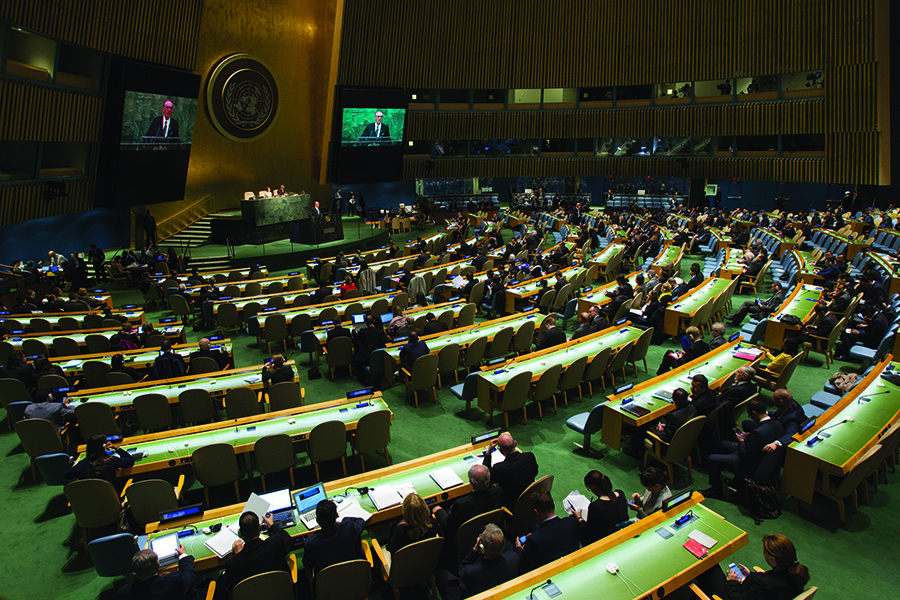"I want to tell you that your fact sheet on the [Missile Technology Control Regime] is very well done and useful for me when I have to speak on MTCR issues."
Toward a Successful NPT Review
November 2021
By Daryl G. Kimball
Twenty-six years ago, as states-parties negotiated the terms for the extension of the nuclear Nonproliferation Treaty (NPT), the future of the treaty was not assured.
 Yet at the 1995 NPT Review and Extension Conference, the world came together, committed to the “complete elimination of nuclear weapons,” and endorsed specific disarmament actions that led to the indefinite extension of this bedrock agreement to reduce the nuclear danger. Additional commitments were made at the 2000 and 2010 review conferences to advance implementation and compliance with all three pillars of the treaty.
Yet at the 1995 NPT Review and Extension Conference, the world came together, committed to the “complete elimination of nuclear weapons,” and endorsed specific disarmament actions that led to the indefinite extension of this bedrock agreement to reduce the nuclear danger. Additional commitments were made at the 2000 and 2010 review conferences to advance implementation and compliance with all three pillars of the treaty.
But since at least 2010, the nuclear disarmament process has stalled; and the five NPT nuclear-armed states (China, France, Russia, the United Kingdom, and the United States) cannot credibly claim they are meeting their NPT Article VI disarmament obligations.
NPT states-parties at the 10th review conference, set for Jan. 2–28, will need to come together on many key issues, including strengthening nuclear safeguards and addressing regional proliferation issues. But the success of this pivotal meeting will hinge, more than anything, on whether and how they can develop an updated, disarmament action plan.
Tensions among the world’s nuclear-armed states are rising, the risk of nuclear use is growing, and hundreds of billions of dollars are being spent to replace and upgrade nuclear arsenals. To varying degrees, the nuclear-armed states are engaged in a qualitative arms race.
In February, at the last moment, U.S. President Joe Biden and Russian President Vladimir Putin extended the New Strategic Arms Reduction Treaty (New START) through 2025. In July, they relaunched a dialogue that could evolve into nuclear disarmament talks. But if they fail to promptly conclude new agreements that limit offensive nuclear weapons and strategic missile interceptors, there will be no legally binding constraints on the world’s two largest arsenals.
Meanwhile, China, France, and the UK are not part of any serious nuclear disarmament discussion; and there is growing evidence that China is preparing to double or triple its long-range, nuclear-armed ballistic missile force.
Due to the growing nuclear disarmament deficit, the NPT regime is once again at a crossroads.
All states need to approach the next NPT review conference with a sense of urgency, a spirit of cooperation, and a determination to produce meaningful results that transcend old fault lines.
Some NPT nuclear-armed states may bemoan the fact that the environment for disarmament progress is “challenging.” We can expect they will continue to claim that many past NPT commitments on disarmament have been overtaken by events. Disarmament progress has never been simple or easy, but such deflections are irresponsible.
Instead, the five nuclear-armed NPT states should acknowledge their past disarmament commitments, work with other states-parties on a pragmatic action plan that sets new benchmarks and deadlines, and pledge to act with the urgency that the grave nuclear weapons threat demands.
To create a more constructive atmosphere, these five states must refrain from further specious attacks against the 2017 Treaty on the Prohibition of Nuclear Weapons (TPNW) and its many supporters. They should acknowledge that the TPNW exists and that supporters consider it to be a contribution to meeting NPT Article VI obligations.
Notwithstanding the different views on how to fulfill those obligations, nuclear-armed and non-nuclear-weapon states should cooperate on a serious disarmament action plan that could include the key elements below.
- A call for the United States and Russia to conclude talks on New START follow-on agreements that achieve further cuts in nuclear warheads and delivery systems no later than 2025.
- A pledge by the five NPT nuclear-armed states to freeze the size of their nuclear arsenals and by all states to halt the production of fissile material for military purposes.
- A call for NPT states to begin disarmament talks in a bilateral or a multilateral format no later than 2025.
- A call for the remaining holdout states to initiate their respective processes to ratify the 1996 Comprehensive Test Ban Treaty by 2025.
- A call for all states to forswear the introduction of nuclear-armed cruise and hypersonic missiles.
- A recognition that any use of nuclear weapons would produce catastrophic humanitarian consequences and that “a nuclear war cannot be won and must never be fought.”
In the absence of coherent and constructive leadership from the nuclear-weapon states, other responsible NPT states-parties need to fill the void to achieve a good NPT conference outcome.
Germany, Kazakhstan, Sweden, and others have made strides toward a common framework on the next steps on nuclear disarmament. Leaders of the humanitarian initiative on nuclear weapons and the Non-Aligned Movement also have a role to play.
Now is the time to bolster the NPT's disarmament pillar.
